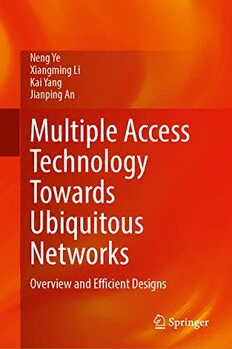Table Of ContentMultiple Access Technology Towards Ubiquitous
Networks
· · ·
Neng Ye Xiangming Li Kai Yang Jianping An
Multiple Access Technology
Towards Ubiquitous
Networks
Overview and Efficient Designs
NengYe XiangmingLi
BeijingInstituteofTechnology BeijingInstituteofTechnology
Beijing,China Beijing,China
KaiYang JianpingAn
BeijingInstituteofTechnology BeijingInstituteofTechnology
Beijing,China Beijing,China
ISBN 978-981-19-4024-8 ISBN 978-981-19-4025-5 (eBook)
https://doi.org/10.1007/978-981-19-4025-5
©TheAuthor(s),underexclusivelicensetoSpringerNatureSingaporePteLtd.2023
Thisworkissubjecttocopyright.AllrightsaresolelyandexclusivelylicensedbythePublisher,whether
thewholeorpartofthematerialisconcerned,specificallytherightsoftranslation,reprinting,reuse
ofillustrations,recitation,broadcasting,reproductiononmicrofilmsorinanyotherphysicalway,and
transmissionorinformationstorageandretrieval,electronicadaptation,computersoftware,orbysimilar
ordissimilarmethodologynowknownorhereafterdeveloped.
Theuseofgeneraldescriptivenames,registerednames,trademarks,servicemarks,etc.inthispublication
doesnotimply,evenintheabsenceofaspecificstatement,thatsuchnamesareexemptfromtherelevant
protectivelawsandregulationsandthereforefreeforgeneraluse.
Thepublisher,theauthors,andtheeditorsaresafetoassumethattheadviceandinformationinthisbook
arebelievedtobetrueandaccurateatthedateofpublication.Neitherthepublishernortheauthorsor
theeditorsgiveawarranty,expressedorimplied,withrespecttothematerialcontainedhereinorforany
errorsoromissionsthatmayhavebeenmade.Thepublisherremainsneutralwithregardtojurisdictional
claimsinpublishedmapsandinstitutionalaffiliations.
ThisSpringerimprintispublishedbytheregisteredcompanySpringerNatureSingaporePteLtd.
The registered company address is: 152 Beach Road, #21-01/04 Gateway East, Singapore 189721,
Singapore
Preface
The future wireless communication networks are expected to provide ubiquitous
massivecoveragetomeettherequirementsofdiversifiedapplications.Withanexpo-
nential increase of the number of users and devices, it is challenging to establish
fastand reliable connections in the ubiquitous network. As the core technology in
the evolution of wireless communication systems, multiple access technology can
enableeffectivemassiveconnectionsandhasbecometheprominentresearchtrend
forubiquitousnetworks.Thegoalofthisbookistoprovidereaderswithacompre-
hensiveoverviewofthestate-of-the-artmultipleaccesstechnologiesforubiquitous
network, with a focus on the novel ubiquitous multiple access technologies, the
signalconstructiontechniquesofmultipleaccessandtheenhancedmultipleaccess
transceivers using Artificial Intelligence (AI). For each of these topics, this book
has tried to provide an advanced introduction, blending the basic multi-user infor-
mationprincipleswiththeadvancedmultipleaccessmodelsandnovelapplication
scenarios.Inaddition,thisbookhasprovidedelaboratesimulationresultsforeach
topictoverifythefeasibilityofthecorrespondingschemes.
Inparticular,tohave acomprehensive viewfortheapplication scenarios ofthe
multiple access technology, this book discusses the evolution and deployment of
multipleaccessin5Gandbeyond,followedbytheemergingmultipleaccesstech-
nologiesdevelopedfortheubiquitousnon-terrestrialnetworks.Facingthechallenges
of massive connections in ubiquitous networks this book investigates the effective
signalconstructiontechniquesofmultipleaccess,includingconstellationdesignand
ratesplitting.Moreover,theenhancementofmultipleaccesstransceiversusingAIis
presented.Specifically,thisbookresortstoAIforconstructingunifiedoptimization
framework and approaching the performance limit of multiple access system, and
enhancesgrant-freemultipleaccesstomatchthefeaturesofInternetofThings(IoT)
withdeeplearning.Thisbooksystematicallydescribesthetheoreticalframeworkand
physical layer technologies of ubiquitous access, which can reflect the application
prospectforfutureubiquitousnetworks.
Webelievethatthisbookcanprovideusefulinsightsforthetheoryandmethodof
ubiquitousmultipleaccess,anddisplaythewideapplicationofubiquitousnetworks
in the future 6G. This book can be used as a reference for graduate students,
v
vi Preface
researchers, and engineers in the field of wireless communications. We do hope
thatthevaluabletimedevotedtothisbookwillbearfruitinstimulatinginterestin
thestudyofmultipleaccesstechnologies.
Beijing,China NengYe
XiangmingLi
KaiYang
JianpingAn
Acknowledgements TheworksinthisbookhavebeensupportedbytheNationalNaturalScience
FoundationofChinaunderGrants62101048and62171030.
Contents
1 Introduction ................................................... 1
1.1 Background ............................................... 1
1.2 EvolutionofMultipleAccessTechnology ...................... 2
1.3 SignalConstructionforMultipleAccessTechnology ............ 3
1.4 AI-EnhancedMultipleAccessTechnology ..................... 4
1.5 Organization ............................................... 4
References ..................................................... 6
2 MultipleAccessTowards5GandBeyond ......................... 7
2.1 Introduction ............................................... 7
2.2 TypicalMultipleAccessTechnologies ......................... 9
2.2.1 Bit-LevelNon-orthogonalMultipleAccess .............. 10
2.2.2 Symbol-LevelNon-orthogonalMultipleAccess .......... 15
2.2.3 Multi-userDetectionTechnologies ..................... 23
2.3 Grant-FreeMultipleAccessformMTC ........................ 28
2.3.1 Motivation .......................................... 28
2.3.2 Grant-FreeProcess ................................... 29
2.3.3 TypicalGrant-FreeMultipleAccessTechnologies ........ 31
2.3.4 DetectionTechniques ................................. 33
2.4 ImplementationIssues ...................................... 35
2.4.1 Scheduling-BasedMultipleAccess ..................... 36
2.4.2 Grant-FreeMultipleAccess ........................... 38
2.5 Conclusions ............................................... 41
References ..................................................... 41
3 MultipleAccessTowardsNon-terrestrialNetworks ................ 47
3.1 Introduction ............................................... 47
3.2 OverviewonNon-terrestrialIoT .............................. 48
3.2.1 SatelliteIoT ......................................... 50
3.2.2 UAVIoT ............................................ 51
3.3 PhysicalLayerTechnologiesofSatelliteIoT ................... 51
3.3.1 WirelessAccessTechnologies ......................... 52
vii
viii Contents
3.3.2 High-EfficacyResourceAllocation ..................... 56
3.3.3 LargeDynamicChannel .............................. 57
3.3.4 MmWaveTransmissionSystem ........................ 58
3.3.5 OtherEnablingTechnologies .......................... 58
3.4 Non-physicalLayerTechnologiesofSatelliteIoT ............... 59
3.4.1 High-EfficacyProtocol ............................... 59
3.4.2 UbiquitousNetworkArchitecture ...................... 59
3.4.3 OtherEnablingTechnologies .......................... 60
3.5 MultipleAccessTechnologiesofUAVIoT ..................... 60
3.5.1 FlexibleDeploymentandRoutePlanning ................ 60
3.5.2 LowPowerConsumptionDesign ....................... 62
3.5.3 CollisionResolutionDesign ........................... 64
3.5.4 LargeDynamicChannel .............................. 64
3.5.5 OtherEnablingTechnologies .......................... 66
3.6 Conclusions ............................................... 68
References ..................................................... 68
4 ConstellationDesignTechniqueforMultipleAccess ............... 77
4.1 Introduction ............................................... 77
4.2 SystemModelandProblemFormulation ....................... 78
4.3 ConstellationRotationMethod ............................... 79
4.3.1 ProblemTransformation .............................. 79
4.3.2 VariationalApproximationMethod ..................... 80
4.4 AnalysisandDiscussions .................................... 82
4.4.1 AchievableCapacitywithSICReceiver ................. 82
4.4.2 AnalysisonInfiniteNumberofReceivingAntenna ....... 83
4.5 SimulationResultsandConclusions ........................... 83
References ..................................................... 86
5 Rate-AdaptiveDesignforMultipleAccess ........................ 87
5.1 Introduction ............................................... 87
5.1.1 RelatedWorkandMotivation .......................... 88
5.1.2 Contributions ........................................ 90
5.2 SystemModel ............................................. 91
5.3 Rate-AdaptiveMultipleAccess ............................... 93
5.3.1 Rate-SplittingPrinciple ............................... 93
5.3.2 RAMAforGrant-FreeTransmission .................... 94
5.3.3 ImplementationIssues ................................ 96
5.4 PerformanceAnalysisofConv-GFandRAMA ................. 97
5.4.1 OutagePerformanceAnalysisofGrant-FreeAccess ....... 97
5.4.2 OutagePerformanceAnalysisofRAMA ................ 102
5.4.3 Comparisons ........................................ 106
5.5 RAMAAmenableConstellations ............................. 108
5.5.1 OverlappingMethod ................................. 108
5.5.2 BundlingMethod .................................... 109
5.6 SimulationResults .......................................... 110
Contents ix
5.6.1 IdealSettings ........................................ 110
5.6.2 RealisticSettings .................................... 112
5.7 Conclusions ............................................... 113
References ..................................................... 117
6 ArtificialIntelligence-EnhancedMultipleAccess .................. 119
6.1 Introduction ............................................... 119
6.1.1 RelatedWorkandMotivation .......................... 120
6.1.2 Contributions ........................................ 121
6.2 SystemModelandProblemFormulation ....................... 122
6.2.1 UplinkNOMASystemModel ......................... 122
6.2.2 ProblemFormulation ................................. 123
6.3 DeepNOMA:AnEnd-to-EndDLFrameworkforNOMA
BasedonMulti-taskLearning ................................ 125
6.3.1 DeepMulti-taskLearning ............................. 125
6.3.2 NetworkStructureofDeepNOMA ..................... 126
6.3.3 Multi-taskBalancingTechnique ........................ 130
6.3.4 TrainingAlgorithm ................................... 132
6.4 DeepMAS:Model-BasedMASMappingNetworkDesign ........ 132
6.4.1 Model-BasedTransmitterDesign ....................... 133
6.4.2 ParameterInitialization ............................... 134
6.5 DeepMUD:InterferenceCancellation-BasedMUDNetwork
Design .................................................... 135
6.5.1 InterferenceCancellationforMultipleAccessChannel .... 135
6.5.2 ICNN:InterferenceCancellation-EnabledDNN .......... 136
6.5.3 DeepMUDBasedonICNN ............................ 138
6.5.4 TrainingDeepMUDoverFadingChannel ............... 140
6.6 SimulationResults .......................................... 141
6.6.1 NetworkTrainingPerformance ........................ 142
6.6.2 DesignExamplesofDeepMAS ........................ 145
6.6.3 PerformanceEvaluationofDeepNOMA ................. 146
6.7 Conclusions ............................................... 149
References ..................................................... 154
7 DeepLearning-AidedHigh-ThroughputMultipleAccess ........... 157
7.1 Introduction ............................................... 157
7.2 SystemModelandProblemFormulation ....................... 160
7.3 DeepLearning-AidedGrant-FreeNOMA ...................... 161
7.3.1 DeepVAEforGrant-FreeNOMA ...................... 161
7.3.2 EncodingNetwork ................................... 163
7.3.3 DecodingNetwork ................................... 164
7.4 Multi-lossBasedNetworkTrainingAlgorithm .................. 165
7.4.1 DatasetOrganizationwithRandomUserActivation ....... 165
7.4.2 Multi-lossFunctionDesign ............................ 166
7.4.3 OverallAlgorithm .................................... 169
7.5 SimulationResults .......................................... 170
x Contents
7.5.1 NetworkTrainingResultsandDesignExamples .......... 170
7.5.2 DetectionAccuracyAnalysis .......................... 172
7.6 Conclusions ............................................... 175
References ..................................................... 175
8 SummaryandOutlook ......................................... 179
8.1 Summary .................................................. 179
8.2 FutureDirections ........................................... 181

